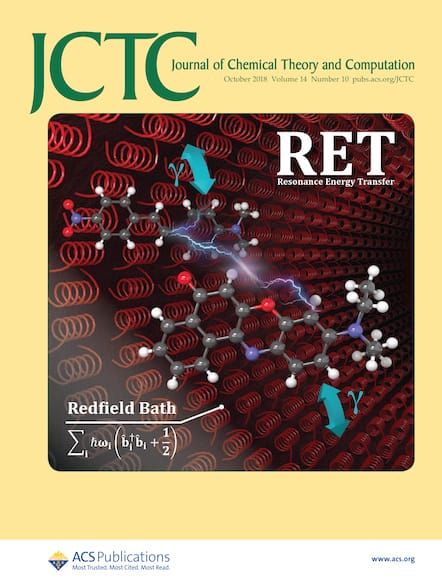竞争反应机制中电场和界面的调制。
IF 5.7
1区 化学
Q2 CHEMISTRY, PHYSICAL
引用次数: 0
摘要
近年来,越来越多的证据表明,电场和水界面影响生物分子的特性和排列,极大地提高了反应速率。原生互变异构是生物系统的一个基本过程;然而,对其电场效应和界面效应的全面认识仍然缺乏。本文采用强化采样的深电位分子动力学技术,从理论上研究了电场调制和界面对溶剂化甘氨酸互变异构动力学的影响。为了更好地描述电场效应,所使用的深度学习电位被训练来整合远程静电相互作用。我们观察到,10 mV/Å的外电场几乎没有改变互变异构反应的关键结构,但显著影响了它们的相对自由能,从而使两性离子([Z])向中性([N])甘氨酸的转化在热力学和动力学上都更容易实现,并改变了分子内质子转移(Intra-PT)到分子间质子转移(Inter-PT)的最佳反应机制阳离子-甘氨酸-氢氧化物离子对。详细分析表明,电场由于熵效应使[N]相对于[Z]的热力学稳定性提高了7 kJ/mol,并通过静电促进离子对的分离促进了Inter-PT途径,使速率决定步骤的自由能垒降低了约10 kJ/mol。有趣的是,在空气-水界面中,由于甘氨酸和水自离子的界面倾向,离子对的分离受到限制,减缓了Inter-PT途径。然而,由于部分溶剂化,甘氨酸的[Z]和[N]形式之间的界面相互转化通过Intra-PT途径动态加速。这些发现为电场和界面如何调节热力学、动力学和化学反应机制提供了新的见解。本文章由计算机程序翻译,如有差异,请以英文原文为准。
Modulation of Electric Field and Interface on Competitive Reaction Mechanisms.
Recently, much evidence has accumulated, showing that electric fields and water interfaces influence the characteristics and alignment of biomolecules and greatly boost reaction rates. The prototropic tautomerism is a fundamental process in biological systems; however, a comprehensive understanding of the electric field effects and interfacial effects on it is still lacking. In this work, we performed a theoretical study of the modulation of the electric field and the interface on the tautomerism dynamics of solvated glycine by using deep potential molecular dynamics technology with enhanced sampling. The deep learning potentials used were trained to integrate long-range electrostatic interactions in order to better describe the electric field effect. We observed that an external electric field of 10 mV/Å barely changed the key structures involved in tautomerism reactions but significantly influenced their relative free energies and consequently made the transformation from zwitterionic ([Z]) to neutral ([N]) glycine more achievable both thermodynamically and dynamically and altered the optimal reaction mechanism from intramolecular proton transfer (Intra-PT) to intermolecular proton transfer (Inter-PT) involving a separate cationic-glycine-hydroxide ion pair. The detailed analysis revealed that the electric field increased the thermodynamical stability of [N] relative to [Z] by 7 kJ/mol due to the entropy effect and promoted the Inter-PT pathway by electrostatically facilitating the separation of ion pairs, causing the free-energy-barrier decrease of the rate-determined step by approximately 10 kJ/mol. Interestingly, in the air-water interface, due to the interfacial propensity of the glycine and water self-ions, the separation of ion pairs is restricted, slowing the Inter-PT pathways. Nevertheless, the interfacial interconversion between the [Z] and [N] forms of glycine is dynamically accelerated via the Intra-PT pathway due to partial solvation. These findings provide new insights into how the electric field and interfaces modulate thermodynamics, kinetics, and the mechanism of chemical reactions.
求助全文
通过发布文献求助,成功后即可免费获取论文全文。
去求助
来源期刊

Journal of Chemical Theory and Computation
化学-物理:原子、分子和化学物理
CiteScore
9.90
自引率
16.40%
发文量
568
审稿时长
1 months
期刊介绍:
The Journal of Chemical Theory and Computation invites new and original contributions with the understanding that, if accepted, they will not be published elsewhere. Papers reporting new theories, methodology, and/or important applications in quantum electronic structure, molecular dynamics, and statistical mechanics are appropriate for submission to this Journal. Specific topics include advances in or applications of ab initio quantum mechanics, density functional theory, design and properties of new materials, surface science, Monte Carlo simulations, solvation models, QM/MM calculations, biomolecular structure prediction, and molecular dynamics in the broadest sense including gas-phase dynamics, ab initio dynamics, biomolecular dynamics, and protein folding. The Journal does not consider papers that are straightforward applications of known methods including DFT and molecular dynamics. The Journal favors submissions that include advances in theory or methodology with applications to compelling problems.
 求助内容:
求助内容: 应助结果提醒方式:
应助结果提醒方式:


